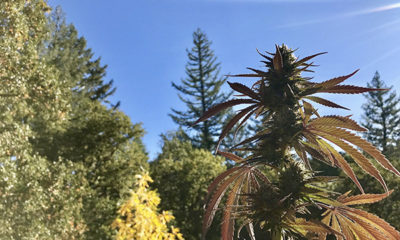
Politics
California Ramps Up Fines For Illegal Marijuana Grows Damaging Ecosystems
A potentially record-breaking El Niño brews out over the Pacific, California dredges mud from dry aquifers, and legislators continue to try and reconcile the state’s environmental catastrophe with the state’s marijuana industry.
On Friday, California Governor Jerry Brown signed into law a bill that levies steep fines against illegal marijuana grows that are diverting streams, killing wild animals, clearing land or dumping waste chemicals into the water supply. The bill comes in response to a state investigation that found California’s illegal cannabis farms stole over 5 million gallons of water in 2014 by diverting and damming streams and rivers, according to the bill’s author Senator William Monning (D-Carmel).
The law does not create new fines, but rather it increases existing fines for those cultivating a controlled substance such as marijuana. For example, illegally dumping waste materials like fertilizers and petroleum into rivers and streams will now be up a fine of $40,000 instead of $25,000. Clearing trees or killing wild animals while cultivating cannabis will now be fined at up to $10,000.
The funds generated from the fines will help pay for the costs of cleaning up grow-sites and restoring habitats, which the National Park Service estimates at about $15,000 per acre for an average grow site of 10-20 acres.
California has seen an explosion of marijuana cultivation in recent years — with the Department of Fish and Wildlife seizing 609,480 marijuana plants and 15,839 pounds of processed marijuana last year alone, according the bill’s language.
“Many of these marijuana grow-sites operate on a commercial scale, leaving behind devastating impacts on the terrestrial and aquatic habitats they occupy,” wrote Monning. “These practices exacerbate California’s already historic drought conditions and severely affect Coho Salmon runs and other fishery populations.”
On Monday, he released a statement thanking the governor for signing his bill and said the increased fines will “provide another tool to fight this growing problem.”
Monning’s bill, SB 165, passed the State Assembly and the State Senate in two unanimous votes, signaling that state legislators are eager to act quickly on drought measures.
However, while marijuana cultivation lobbyists agree that stream diversion and pollution should be stopped, they argue that the bill’s fines will not deter illegal growers and might even exacerbate the problem.
Hezekiah Allen, director of the Emerald Grower’s Association, said that because illegal marijuana growers are already facing harsh punishment with jail time and seizure of harvests, they are not incentivized by the relatively small punishment of higher fines.
Instead, the Emerald Grower’s Association — an organization representing medical cannabis cultivators in California — advocates for a regulatory system where marijuana growers can receive a business license when they prove compliance with state environmental laws.
“Fines and penalties aren’t addressing the issues here,” Allen said. “Increasing the fines and the penalties without creating a regulatory structure and marijuana business licenses won’t work.”
Under a state business licensing system, marijuana cultivators would have to demonstrate compliance with the state’s environmental standards and could be inspected by the state’s Water Board in order to receive a license and protection from persecution. One bill currently working through the California State Assembly, AB 266, creates such a business license program for medical marijuana growers, and Allen believes it will pass.
In fact, Allen argues, without business licenses, cannabis cultivators are actually incentivized to operate in the cheapest ways that hurt the environment the most.
“If you’re already facing the worst consequences for growing, you’re not going to invest in your farm,” Allen said. “You’re not going to invest in water storage and irrigation. Those people who are making that investment are at a disadvantage in the market because they’re spending more on environmental infrastructure.”
Scott Bauer, a senior environmental scientist with the Department of Fish and Wildlife, estimated that only 1 percent of marijuana farms in the Humboldt area where he works have obtained the proper permits from the state to use water appropriately. The good news, he said, is that the number of people seeking permits has recently begun to increase.
“We have seen more people coming in and applying for permits and the total number of permitted sites increasing as people see government attitudes change toward marijuana,” said Bauer. “It’s still a fraction, but it’s increasing.”
For this reason, Bauer said, he supports legislation that encourages a collaborative effort between the marijuana industry and the government, such as AB 266, and another bill, AB 243, that would incentivize environmental best practices for marijuana growers through the Department of Food and Agriculture.
“These bills will help people feel more comfortable coming to us to get their operations permitted,” Bauer said.
In March, Bauer published a study on the effect of marijuana grows in Northern California that found various marijuana farms illegally siphoning water up to 200 times within a single watershed, threatening populations of endangered salmon, steelhead trout, salamanders, frogs and other critters.
“We chose and measured stream flow in five watersheds, four with significant marijuana cultivation and one control watershed that didn’t have marijuana cultivation,” said Bauer. “All of them went dry except for the control watershed. That’s a pretty good indicator that there may be a problem with marijuana cultivation.”
Most calculations comparing crops’ water requirements find that marijuana cultivation alone is not to blame for California’s drought, and Allen estimates that the state’s marijuana grows take only about 10,000 acre feet of water compared to the state’s agriculture industry which uses 40 million acre feet.
However, removing the water close to the source and leaking chemicals into the streams up in the mountains causes a “cascading effect” down through the watershed, Bauer said, which has already been made delicate by the drought.
Both Bauer and Allen agree that government regulations that distinguish between black market illegal marijuana growers and legitimate medical growers adopting sustainable practices would see tangible benefits for the environment.
What do you think? Will fines deter illegal grows? Tell us below.
























